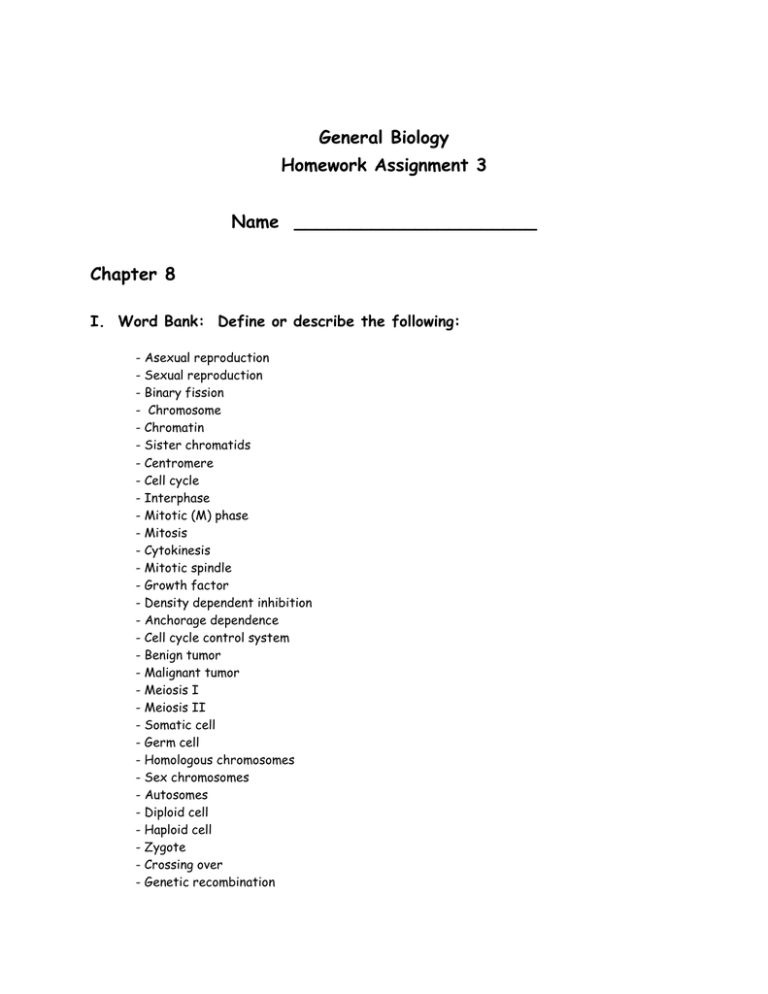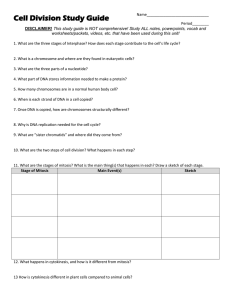Homework 3
advertisement

General Biology Homework Assignment 3 Name ______________________ Chapter 8 I. Word Bank: Define or describe the following: - Asexual reproduction - Sexual reproduction - Binary fission - Chromosome - Chromatin - Sister chromatids - Centromere - Cell cycle - Interphase - Mitotic (M) phase - Mitosis - Cytokinesis - Mitotic spindle - Growth factor - Density dependent inhibition - Anchorage dependence - Cell cycle control system - Benign tumor - Malignant tumor - Meiosis I - Meiosis II - Somatic cell - Germ cell - Homologous chromosomes - Sex chromosomes - Autosomes - Diploid cell - Haploid cell - Zygote - Crossing over - Genetic recombination - Karyotype - Trisomy 21 - Nondisjunction - Deletion - Duplication - Translocation II. Short answer. Answer the following questions in complete sentences unless otherwise noted. 1. Fill in the table above comparing mitosis and meiosis. 2. Distinguish between events in interphase, mitosis, and cytokinesis. 3. Describe the movements of chromosomes in prophase, metaphase, anaphase, and telophase of mitosis. 4.Distinguish between terms in the following groups: a. haploid—diploid b. sister chromatids—nonsister chromatids c. deletion—duplication—translocation 5. Describe how genetic variability is generated through meiosis and fertilization. 6.Identify factors that control cell division and describe how cancer cells escape these controls. Chapter 9 I. Word Bank: Define or describe the following: - Genetics Character Trait Self-fertizilize Cross-fertilize Hybrids Cross Monohybrid cross Dihybrid cross Alleles Homozygous Heterozygous Dominant allele Recessive allele Locus Law of segregation Phenotype - - Genotype Law of independent assortment Testcross Rule of multiplication Rule of addition Pedigree Inbreeding Complete dominance Incomplete dominance Codominant ABO blood group Pleiotropy Polygenic inheritance Chromosome theory of inheritance Sex chromosomes Sex-linked genes II. Short answer. Answer the following questions in complete sentences unless otherwise noted. 1. Complete the concept map above to review concepts of genetics. 2. Explain Mendel’s laws of segregation and independent assortment. 3. Describe the following disorders and give an example of each: a. Recessive disorder b. Dominant disorder c. Pleiotropic disorder d. Sex-linked disorder 4. Describe how sex is inherited in humans and identify the pattern of inheritance observed for sex-linked genes. Solve the following genetics problems involving monohybrid and dihybrid crosses for autosomal and sex-linked traits, with variations on Mendel’s laws: 5. Tim and Jan both have freckles, but their son Mike does not. Show with a Punnett square how this is possible. If Tim and Jan have another child, what is the probability that he/she will have freckles? 6. A fruit fly with a gray body and red eyes (genotype BbPp) is mated with a fly having a black body and purple eyes (genotype bbpp). What offspring, in what proportions, would you expect if the body-color and eye-color genes are on different chromosomes ? 7. A couple are both phenotypically normal but their son suffers from hemophilia, a sex-linked recessive disorder. What fraction of their children are likely to suffer from hemophilia? What fraction are likely to be carriers? Chapter 10 I. Word Bank: Define or describe the following: - Double helix - 3’ end - 5’ end - Semiconservative model of replication - DNA polymerase - DNA ligase - Leading strand - Lagging strand - Transcription - RNA polymerase - Promoter - Terminator - mRNA - tRNA - rRNA - Codon - Start codon - Stop codon - Translation - Genetic code - Degeneracy - Ribosomes II. Short answer. Answer the following questions in complete sentences unless otherwise noted. 1. Complete the concept map above. 2. Compare and contrast the structures of DNA and RNA. 3. The base sequence of the gene coding for a short polypeptide is 3’ CTACGCTAGGCGATTGACT 5’. What would be the base sequence of the mRNA transcribed from this gene? Using the genetic code in Figure 10.8A, give the amino acid sequence of the polypeptide translated from this mRNA. (Hint: What is the start codon?) 4. Explain the terms universal and degenerate in relation to the genetic code. Chapter 12 I. Word Bank: Define or describe the following: - Recombinant DNA - Plasmids - Vectors - Gene cloning - Genetic engineering - Vaccine - Genetically modified (GM) organism - Transgenic organism - Gene therapy - DNA profiling - Forensics - PCR - Gel electrophoresis - RFLP II. Short answer. Answer the following questions in complete sentences unless otherwise noted. 1. Imagine you have found a small quantity of DNA. Fill in the above diagram, which outlines a series of DNA technology experiments you could perform to study this DNA. 2. Distinguish between terms in the following groups: a. restriction enzyme—DNA ligase b. GM organism—transgenic organism c. SNP—RFLP d. genomics—proteomics 3. Describe the following applications of gene cloning: a. Therapeutic drugs b. Vaccines c. Gene therapy d. DNA profiling 4. Describe 4 ways that DNA profiling is used.






